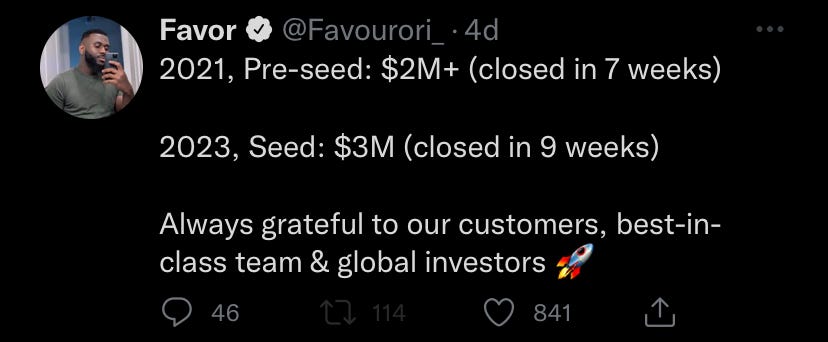The Future of e-Commerce in Africa - Tabbing Takes 07
+ Payday’s new $3M Payday & $40 Million Acquisition Rumour, Conversion Franchising & an Employee Bus Shuttle Service $4M raise.
Welcome to another issue of Tabbing Takes. A series that looks into the most interesting trends and news coming out of Africa's digital economy and startup culture.
No delays in delivery, no trust issues with customers, and no failed payments.
This is the dream of every company, especially e-commerce companies.
The future of e-commerce on the continent hangs on the innovation taking place today in the sector. The current reality of e-commerce in Africa can signal what the future holds.
e-Commerce is performing two important roles in Africa;
It's reducing the barriers to entry in retail and encouraging millions of Africans to be economically active, especially via Social commerce and the use of Payment provider storefronts.
and also aggregating the fragmented retail sector on the continent via B2B e-commerce.
When the likes of Jumia, Konga, Zando, and Takealot.com, all Business-to-consumer (B2C) marketplaces, raised a combined $855 million between 2012 and 2015. There was a ton of optimism about e-commerce in Africa.
But between 2017 and 2019 many of these e-commerce companies either downsized, restructured or folded up. Some prime examples are Dealday, Efritin, OLX, and Konga.
African e-commerce companies continue to face unique challenges.
The absence of functional addressing systems, poor road and logistics networks, and the general preference for cash payments continue to make e-commerce a tough nut to crack on the continent, especially for B2C Marketplaces.
Other noteworthy challenges in the African e-commerce sector are low banking rates (57% of the African population do not have a traditional bank account), and low consumer trust which is a result of inadequate consumer protection and poor legal regulation in the e-commerce industry.
Then you have to consider the transaction costs of buying online in Africa.
Transaction costs for online shopping can be relatively high even for small purchases, and since most consumers on the continent have low purchasing power, they prefer cash payments, which is seen as a “free” payment option.
If Commerce in Africa continues to happen mostly offline and in cash transactions, it would stall e-commerce adoption on the continent. Today, 90% of transactions in Africa are still in cash.
Despite the rise of mobile money on the continent, the majority of the population continues to prefer cash as the mode of payment.
The latest cash crisis in Nigeria if anything is another testament to the strong affinity African shoppers have for cash.
Another significant challenge for e-commerce is KYC (Know Your Customer) for Merchant payment processing. KYC is how we use government-issued documents (Paper identities) as proof of identity/address) in finance.
Since a lot of MSMEs are small businesses lacking company formation documents, whenever these businesses process large payments (usually in multiple small transactions), these payments can get flagged as fraudulent activity.
Despite the difficulties faced by Jumia and Co, new trends and business models are emerging in the continent’s e-commerce space.
Payment Provider Storefronts like Paystack Storefront and Flutterwave Stores are being used by small merchants as an add-on to their already heavy social commerce usage. These Fintech-powered e-commerce platforms (payment provider storefronts) are becoming an entry point for willing participants in the continent's e-commerce space.
Meanwhile, most of the continent’s digital commerce is happening via Social commerce since social media apps account for the majority of the e-commerce activity on the continent.
African merchants, vendors and small retailers notably use Facebook, Instagram, and WhatsApp to access the millions of Africans who prefer to use social media apps for online shopping more than e-commerce marketplaces.
We are also seeing the digitization of Africa’s offline retail space — a distribution network of small shop owners, dealers, stockists, wholesalers, and distributors — serving local customer demand. B2B e-commerce startups like Wasoko, Marketforce, Trade Depot, Alerzo, Omnibiz, Sle3ti, Valease and Sabi are enabling this digitization alongside e-commerce enablement tools like Selar, Bumpa, Simpu, and Heroshe.
Then there’s the slowly rising trend of Q-commerce (quick commerce), the new fast form of e-commerce that involves on-demand delivery (typically around 1 hour) of groceries and food.
E-commerce will always require retail fulfilment(physical spaces for processing and shipping customer orders), so we are seeing retail spaces turned into mini depots, as new partnerships form between third-party delivery platforms that want to offer customers more choices and physical retailers that can’t afford the costs of last-mile delivery.
Some Q commerce and food commerce startups in Africa are Appetito, Glovo, Rabbit, Chowdeck, Mano, PricePally and HeyFood.
Demographically, Africa has the youngest and the second-largest population in the world. Therefore in the not-so-far future, the African continent will potentially be home to the biggest digital audience in the world.
By 2025 half a billion people in Africa will be e-commerce users and digital commerce could add $180 billion to the region’s GDP by the same year. But first, it has to stop the bleeding of young talented migrants leaving the continent in search of greener pastures.
When you combine Africa’s population potential with the rising internet penetration on the continent as well as the spread of digital payments in African countries, you have a recipe for the growth of e-commerce in Africa.
Also, it seems Africa is ripe for global players as Amazon plans to expand into five African, European, and South American countries — Belgium, Chile, Colombia, Nigeria, and South Africa. With the company registering the domains "Amazon.com.ng" and "Amazon.co.za".
Then there’s Walmart's slow entry into the continent’s e-commerce space as it takes full control of South Africa’s retail group; Massmart.
While this means competition for local e-commerce players in these countries, it shows that Africa is now an investment case good enough for global companies like Amazon to want to come here.
Meanwhile, there’s a new business model on the block that might be a viable path for e-commerce on the continent. The B2B2C (Business-to-business-to-consumer) model.
Companies have historically relied on two primary options when selling products: sell to a business (B2B) or a consumer (B2C). But the internet has blurred the lines between both sales channels, giving rise to the B2B2C framework.
Business-to-business (B2B) solutions with a complementary B2C model can operate maximally by creating stronger systemic value by selling their product or service in partnership with a third party.
The B2B2C model perfectly lends itself to B2B e-commerce startups digitizing retail markets in Africa.
An interesting application of the B2B2C model is Conversion franchising.
Franchises are for people who want a “business-in-a-box”, and who don’t want to take the full risk of starting their own business from scratch.
With franchising, a company will let you borrow their brand, train you on how to run your local version of the business, get needed supplies to you, lend you money for things like equipment and maintenance, and so much more.
Franchises like McDonald’s just set it up for you; you just have to run it.
On the other hand, Conversion franchising transforms pre-existing, independently-owned businesses into members of a standardized network.
A good example of conversion franchising in Africa is QualityRx by mPharma, a “pharmacy in a box” service.
It is a tech-enabled conversion franchising solution that unites community pharmacies under one brand, Mutti.
A Mutti pharmacy receives technology, marketing expertise and insights that increase its business growth and profitability.
Through QualityRx, mPharma provides mom-and-pop pharmacies with services and programs that help them compete more effectively in their local communities. They refurbish community pharmacies with contemporary décor and brand signage reinforcing their commitment to personalised care.
mPharma’s mission for Mutti is for every Mutti pharmacy to be associated with high-quality medicines, low prices and a fantastic customer experience. Pharmacies that have joined the Mutti network are more than doubling the revenues they were making before joining the network.
Franchising isn’t really a new idea in retail. You have to understand that despite people making fortunes off franchises, they can be a really cutthroat business. However, there are tons of franchise opportunities existing outside food chains and sports and in other sectors like health and digital commerce.
There are a lot of things that need to happen for the positive development of e-commerce in Africa.
Daniele Tricarico of GSMA put it succinctly:
“ Technology innovation is part of the solution, but there is a need to continue working on building trust in digital commerce, not only at the payment layer, but more generally between consumer and merchant, and between merchant and technology provider, to interact and do business digitally.”
To fulfil the continent’s e-commerce potential, African countries will have to strengthen both local electronic payments and cross-border payments, enact the CFTA (Continental Free Trade Area), and develop and implement wholesome digital Identity systems continent-wide.
Also, e-commerce is a great opportunity for women to overcome gender barriers, when it comes to starting a business. So improving/closing the gender gaps in e-commerce in Africa can provide an extra $15 Billion opportunity to the industry, and this is just between 2025-2030.
No Extra $40 million for Payday Yet
You might belong to the crowd that thinks Payday’s gorilla-style marketing might be genius or the camp that believes it can only have cracks because of things like incessant push notifications, and the number of ads the company has rained down on social media.
Well, payday has raised a new $3 Million Seed round. The startup lets Nigerians create foreign virtual cards and lets users send and receive money. The startup positions itself as the cross-border neobank for Africans.
A few days after the fintech company announced its new raise, a tech journo released an article saying that Moniepoint (who has a banking license and recently raised $39 million taking its total funding activity to $105 million) is in talks to acquire Payday for $40 million.
Well, Moniepoint refuted the news.
You may ask is this another marketing tactic from one the fastest-rising fintech company in Nigeria, or is there some truth to the deal? Well, time will tell.
Or it will be swept under the sand-filled carpet of African tech rumours.
Either way, with over 330,000 users and 40,000 daily transactions, Payday is playing an interesting game and eventually, we’ll see how far they go.
For now, it is day 1 for Payday.
Shuttlers Gets $4M to Scale Employee Bus Service
Shuttlers is a bus-sharing platform that allows individual and corporate passengers to take rides on multiple bus routes via an app.
The startup partners with companies so they can offer transportation perks to their employees, especially those in urban African cities. Companies pay full fares for employees or they split fares with employees, while individual customers pay the fares themselves.
Shuttler’s fares range from N850 (~$1.96) to N1300 (~$2.60).
The startup currently operates in Abuja and Lagos.
With the new $4 Million raise, Shuttlers has raised $5.6 Million in total.
The ride-share startup also has an environmental impact narrative going for it as it claims to have reduced its commuters’ carbon footprint by 85% (about 4 million pounds of carbon dioxide emission).
Now Shuttlers wants to expand to 5 new cities.
While ride-sharing may be the future of transportation on the continent, it is important to recalibrate our expectations of this maturing industry especially as regulation and drivers’ welfare continue to be significant factors in the growth of the industry.
But is a bus ride-sharing service able to take market share from Uber and the like?
At the moment Shuttlers is proving that it’s possible.
Happy Holidays! Till next time.
— Fosi









